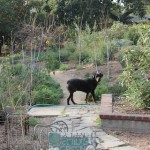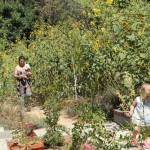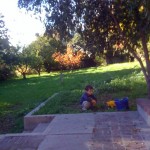Sunflower epilogue
Posted on | January 21, 2012 | 5 Comments
Last summer I wrote about using western sunflowers as a transition plant when converting from lawn to a native garden. Delighted by the explosion of wildflowers across a 9,000 square foot back lot, I explained how the plants conferred shade to young sages and shrubs such as manzanita and ceanothus, how little irrigation the sunflowers required, how they suppressed recurrence of grass and weeds and how they were bee and finch magnets. It was reasonable to surmise that using sunflowers is to native gardening what Atkins is to diets. This is true, with a catch.
What I didn’t describe, because I hadn’t faced it yet, was what happens as the sunflowers become woody and senescent and what is involved in clearing them.
This, my fellow gardeners, can be done slowly or fast.
I did it slowly.
Part of it was being a good hostess. The avidity of the finches for the dried seed heads was striking. Plants that looked old and ready for the chop to me looked like a living bird feeder to them. Worries about explosive regeneration if I left old seed heads around to shed were tempered by the sneaking impression that the birds were gleaning with forensic hunger. This sense was reinforced on inspecting emptied seed heads. However strong the recurrence, sunflower seedlings are distinctive and, unlike grass, easily weeded.
Thinning the senescent sunflowers required hand pruners and a saw. Unlike modern sunflower hybrids, helianthus annuus in the wild have many arterial branches, which flower for months, even a year. The plants can become the size of large bushes or small trees.
Removing old plants begins with trimming away arterial branches. If the outer branches were entangled in neighboring plants, I left them. If they came free easily, I trimmed the seed heads into one pile, stripped leaves into another and cut up the wood into lengths ranging from a ruler to a yardstick. By the time I was ready to cut the main stem, I was often dealing with something six to eight feet tall with stems as thick as two to three inches at the base. I left the stumps in the ground. The far-reaching live roots mean that tearing them out will be arduous and wreck your soil structure. Letting them die back naturally makes them easy to kick out or pull in a month or two. I understand through the local garden mafia that Scott Kleinrock at the Huntington’s Urban Agriculture project left full stalks in his garden there to trellis next season’s climbers.
Sunflower leaves and stems are irritating to the skin. If you get scratchy and frustrated during the thinning, it helps to remember that the more systematic the pruning is during the initial reduction, the easier it will be to handle the trimmings later. There are always gloves. As I got the swing of it, seed heads and small wood ended up in a pile left for final gleaning by birds before turning into compost. If you possess a grinder or mower, then grinding or mowing the seed heads and tiny branches supporting them will speed their breakdown.
When it came to the salvageable wood, this was laid out by size for final trimming and bundling. You can of course throw the wood away. Faced with many plants to deconstruct, I considered it often, a crafty inner voice taunting me, “Who would know other than the trash hauler?”
That lazy inner devil may have prevailed had I not long been taken by displays of wattle-work by skilled English gardeners, and realized that the sticks involved hadn’t come from a stick store, but from the craft-based and conservation-minded gardening that sets good English landscapes apart as so right, such living expressions of place.
At first I stored sticks loosely. After a windstorm with 80mph gusts blew threw, sending my sunflower bits hither and yon, I took to making what the English call faggots, or trussed bundles of wood.
The decision to strip the foliage, trim branches, sort them for length and save the wood for wattle still feels a bit eccentric and gives me pause about the real world applications of sunflowers as a tool during conversion from turf to more sustainable native gardens. But as the manzanitas, sages, buckwheats and artemisias sheltered by the sunflower field last summer emerge from the pruning, I’m struck by their health, how little water they needed, how untrammeled they remain in a garden routinely trafficked by children and dogs and how little competition they suffered from recurring lawn. The sustenance offered to bees and finches was such that towering native sunflowers and their grateful denizens will always fill my garden’s perimeters.
As for the wattle wood, some of it has gone into vegetable garden borders. The rest is sorted, bound and ready for service in trellises, tee-pees or, hello Buckminster Fulller, a geodesic dome, perhaps?
The photos span a roughly 14-month period from first inheriting this garden in late November 2010 to day before yesterday, or mid-January 2012. To read captions to the photos, hold your cursor over the image. To enlarge them, click.
Comments
5 Responses to “Sunflower epilogue”
Leave a Reply











January 22nd, 2012 @ 10:33 am
I’m glad you referenced the English way of dealing with sticks.
I watched a farmer go through a hedge row and half cut through and bend the hazelnut branches weaving them into the hedge.
This keeping them growing and providing a natural fence for his cow pasture, and an invaluable habitat for the wild animals birds and blackberry brambles. No starvation in that hedge row.
January 23rd, 2012 @ 9:45 am
I love this plant – its one of the few roadside “weeds” I am always happy to see. Too bad Helianthus nuttallii ssp. parishii, the Los Angeles sunflower is thought extinct; it was said to be smaller at .4 – 2 meters high. There might be one out there somewhere. Treasure hunt anyone?
http://www.kew.org/msbp/extinct/database/Compositae_Helianthus_nuttallii_ssp._parishii.htm
January 23rd, 2012 @ 9:47 am
What a great link, Drew. Thank you. I’m on for the hunt. The tell-tale slender leaves in the drawing as well as the size should help with the keying.
January 23rd, 2012 @ 11:31 am
Wait, I thought it WAS rediscovered:
http://www.naturespeace.org/lasunflowerlatimes.htm
http://www.cnps.org/cnps/conservation/newhall_ranch.php
Did Newhall Ranch end up killing the last population knowingly? I wouldn’t put it past them. If not, I hope it is entered into cultivation in a way that does not jeopardize that last population. It has great restoration potential.
January 29th, 2012 @ 1:24 am
Emily, thank you for your delightfully candid post. Found your blog via Barbara Eisenstein. Missing your column at LA Times. Look forward to following your blog here. All the best!